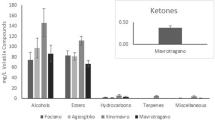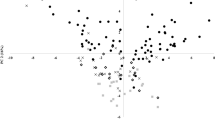Abstract
The aim of this study was to identify chemical markers of commercial tropical red wines with the potential to apply for the Geographical Indication-GI São Francisco Valley. Volatile organic compounds of nine different commercial red wines from the São Francisco Valley, located in the Caatinga region of Brazil, that meet the classic oenological parameters for commercialization, were extracted and separated by the HS-SPME/GC–MS technique, and identified. A total of 103 volatile compounds were identified and classified into 13 chemical groups, of which the esters and alcohols were the majority groups. Similarities were found in the composition of 27 compounds identified in all wines; however, the cultivars influenced the distinction of volatiles expressed exclusively in only one type of wine. Among these, 22 compounds were highlighted for having been identified for the first time in wines, such as 3-phenyl-undecane and 4-phenyl-decane. These exclusive compounds are possible markers which confirm the typicality of tropical red wines of this region, and can contribute to the qualitative description and enhancement of regional identity for wines from the São Francisco Valley.



Similar content being viewed by others
Data Availability
The datasets generated during and/or analyzed during the current study are available from the corresponding author on reasonable request.
References
Alañón ME, Pérez-coello MS, Marina ML (2015) Wine science in the metabolomics era. Trends Anal Chem 74:1–20. https://doi.org/10.1016/j.trac.2015.05.006
Barros EP, Moreira N, Pereira GE et al (2012) Development and validation of automatic HS-SPME with a gas chromatography-ion trap/mass spectrometry method for analysis of volatiles in wines. Talanta 101:177–186. https://doi.org/10.1016/j.talanta.2012.08.028
Bonino M, Schellino R, Rizzi C, et al (2003) Aroma compounds of an Italian wine ( Ruche ´ ) by HS – SPME analysis coupled with GC – ITMS. 80:125–133
Brasil (2018) Instrução normativa n° 14, Fevereiro (2018). Complementação dos padrões de qualidade dos vinhos e derivados da uva e do vinho
Caliari V, Burin VM, Rosier JP, BordignonLuiz MT (2014) Aromatic profile of Brazilian sparkling wines produced with classical and innovative grape varieties. Food Res Int 62:965–973. https://doi.org/10.1016/j.foodres.2014.05.013
Condurso C, Cincotta F, Tripodi G et al (2016) Effects of cluster thinning on wine quality of Syrah cultivar (Vitis vinifera L.). Eur Food Res Technol 242:1719–1726. https://doi.org/10.1007/s00217-016-2671-7
da Mota RV, Peregrino I, Silva CPC et al (2020) Row orientation effects on chemical composition and aromatic profile of Syrah winter wines. Food Sci Technol. https://doi.org/10.1590/fst.38219
da Silva Padilha CV, Biasoto ACT, Corrêa LC et al (2017) Phenolic compounds profile and antioxidant activity of commercial tropical red wines (Vitis vinifera L.) from São Francisco Valley, Brazil. J Food Biochem 41:1–9. https://doi.org/10.1111/jfbc.12346
de Mello MLR, Machado CAE (2020) Viticultura brasileira: panorama 2019.Embrapa 214
de Oliveira JB, Faria DL, Duarte DF et al (2018) Effect of the harvest season on phenolic composition and oenological parameters of grapes and wines cv. ‘Touriga Nacional’ ( Vitis Vinifera L.) produced under tropical semi-arid climate, in the state of Pernambuco, Brazil. Cienc e Tec Vitivinic 33:145–166. https://doi.org/10.1051/ctv/20183302145
De Oliveira JB, Egipto R, Laureano O et al (2019) Chemical composition and sensory profile of Syrah wines from semiarid tropical Brazil – rootstock and harvest season effect. LWT - Food Sci Technol 114:108415. https://doi.org/10.1016/j.lwt.2019.108415
de Pinho PG, Falqué E, Castro M et al (2007) Further insights into the floral character of touriga nacional wines. J Food Sci 72. https://doi.org/10.1111/j.1750-3841.2007.00405.x
Drappier J, Thibon C, Rabot A, Geny-denis L (2017) Relationship between wine composition and temperature : Impact on Bordeaux wine typicity in the context of global warming — review. Crit Rev Food Sci Nutr 59:14–30. https://doi.org/10.1080/10408398.2017.1355776
El-hefny M, Mohamed AA, Salem MZM, El-kareem MSMA (2018) Chemical composition, antioxidant capacity and antibacterial activity against some potato bacterial pathogens of fruit extracts from Phytolacca dioica and Ziziphus spina-christi grown in Egypt. Sci Hortic (Amsterdam) 233:225–232. https://doi.org/10.1016/j.scienta.2018.01.046
Englezos V, Rantsiou K, Cravero F et al (2018) Volatile profiles and chromatic characteristics of red wines produced with Starmerella bacillaris and Saccharomyces cerevisiae. Food Res Int 109:298–309. https://doi.org/10.1016/j.foodres.2018.04.027
Garaguso I, Nardini M (2015) Polyphenols content, phenolics profile and antioxidant activity of organic red wines produced without sulfur dioxide/sulfites addition in comparison to conventional red wines. Food Chem 179:336–342. https://doi.org/10.1016/j.foodchem.2015.01.144
Grygorieva O, Klymenko S, Vergun O et al (2017) Morphological characteristics and determination of volatile organic compounds of Diospyros virginiana L. genotypes fruits. Slovak J Food Sci 612–622. https://doi.org/10.5219/808
Ilc T, Werck-Reichhart D, Navrot N (2016) Meta-analysis of the core aroma components of grape and wine aroma. Front Plant Sci 7:1472. https://doi.org/10.3389/fpls.2016.01472
Ivanova-Petropulos V, Hermosín-Gutiérrez I, Boros B et al (2015) Phenolic compounds and antioxidant activity of Macedonian red wines. J Food Compos Anal 41:1–14. https://doi.org/10.1016/j.jfca.2015.01.002
Jackson RS (2020) Wine sciene: principles and applications, 5th edn. Academic Press
Jiang B, Xi Z, Luo M, Zhang Z (2013) Comparison on aroma compounds in Cabernet Sauvignon and Merlot wines from four wine grape-growing regions in China. Food Res Int 51:482–489. https://doi.org/10.1016/j.foodres.2013.01.001
Karabagias IK, Sykalia D, Mannu A, Badeka AV (2020) Physico - chemical parameters complemented with aroma compounds fired up the varietal discrimination of wine using statistics. Eur Food Res Technol 1–16. https://doi.org/10.1007/s00217-020-03568-y
Lima MS, Leite APS, Sampaio YC et al (2015) Influences of the harvest season on analytical characteristics of syrah grapes and wines produced in the northeast region of Brazil. Int J Agric for 5:151–159. https://doi.org/10.5923/j.ijaf.20150502.09
Lombardi G, Cossignani L, Giua L et al (2017) Phenol composition and antioxidant capacity of red wines produced in Central Italy changes after one-year storage. J Appl Bot Food Qual 90:197–204. https://doi.org/10.5073/JABFQ.2017.090.025
Miele A, Rizzon LA (2011) Discrimination of Brazilian red varietal wines according to their sensory descriptors. Cienc Agrotecnol 35:1172–1177
OIV (2014) Recueil des méthodes internationales d’analyse des vins et des moûts. In: Paris,France Off. Int. la Vigne du Vin
Orlando TGS, Junior PMJ, Santos AO, Hernades JL (2008) Yield-related performance of cv Cabernet Sauvignon and Petite Syrah on different rootstocks. Cien e Agrotecnologia 32:749–755
Parker M, Capone DL, Francis IL, Herderich MJ (2017) Aroma precursors in grapes and wine: flavor release during wine production and consumption. J Agric Food Chem 66:2281–2286. https://doi.org/10.1021/acs.jafc.6b05255
Pereira GE (2020) The three different winegrowing zones in Brazil according to climate conditions and vine managements. In: Jordão and Botelho,Vitis: Biology and Species
Pereira GE, Guerra C., de Amorim FM, et al (2018) Vinhos Tropicais do Semiárido do Brasil Desvendando o potencial Vitivinícola desta Nova Fronteira Geográfica do Vinho. Embrapa Uva e Vinho-Artigo em periódico indexado
Petronilho S, Lopez R, Ferreira V et al (2020) Revealing the usefulness of aroma networks to explain wine aroma properties: a case study of Portuguese wines. Molecules 25. https://doi.org/10.3390/molecules25020272
Pherobase (2020). http://www.pherobase.com/database/kovats/kovatsindex.php
Rankine B (1999) Manual práctico de enología. 1st Edition; Editorial Acribia, SA. Publisher: Zaragoza, Spain
Ribéreau-Gayon P, Dubourdieu D, Donèche B, Lonvaud A (2006) Handbook of enology, Volume 1: The microbiology of wine and vinifications. Wiley
Ruiz J, Kiene F, Belda I et al (2019) Effects on varietal aromas during wine making: a review of the impact of varietal aromas on the flavor of wine. Appl Microbiol Biotechnol 103:7425–7450. https://doi.org/10.1007/s00253-019-10008-9
Sánchez-Palomo E, Trujillo M, García Ruiz A, González Viñas MA (2017) Aroma profile of malbec red wines from La Mancha region: chemical and sensory characterization. Food Res Int 100:201–208
Tang H, Zhao T, Sheng Y, et al (2017) Dendrobium officinale Kimura et Migo : a review on its ethnopharmacology, phytochemistry, pharmacology, and industrialization. Evidence-Based Complement Altern Med 2017
Valentin L, Barroso LP, Barbosa RM et al (2020) Chemical typicality of South American red wines classified according to their volatile and phenolic compounds using multivariate analysis. Food Chem 302. https://doi.org/10.1016/j.foodchem.2019.125340
Vilanova M, Campo E, Escudero A et al (2012) Analytica Chimica Acta Volatile composition and sensory properties of Vitis vinifera red cultivars from North West Spain : Correlation between sensory and instrumental analysis. Anal Chim Acta 720:104–111. https://doi.org/10.1016/j.aca.2012.01.026
Voce S, Škrab D, Vrhovsek U et al (2019) Compositional characterization of commercial sparkling wines from cv. Ribolla Gialla produced in Friuli Venezia Giulia. Eur Food Res Technol 245:2279–2292. https://doi.org/10.1007/s00217-019-03334-9
Funding
This study is funded by the winery for the partnership and Coordination for the Improvement of Higher Education Personnel (Coordenação de Aperfeiçoamento de Pessoal de Nível Superior-Capes).
Author information
Authors and Affiliations
Corresponding author
Ethics declarations
Informed Consent
Informed consent is not applicable.
Conflict of Interest
The authors declare no competing interests.
Additional information
Publisher's Note
Springer Nature remains neutral with regard to jurisdictional claims in published maps and institutional affiliations.
Rights and permissions
About this article
Cite this article
de Macêdo Morais, S., de Sousa Galvão, M., Olegario, L.S. et al. Identification of Chemical Markers of Commercial Tropical Red Wine Candidates for the São Francisco Valley Geographical Indication. Food Anal. Methods 15, 1237–1255 (2022). https://doi.org/10.1007/s12161-021-02225-8
Received:
Accepted:
Published:
Issue Date:
DOI: https://doi.org/10.1007/s12161-021-02225-8




